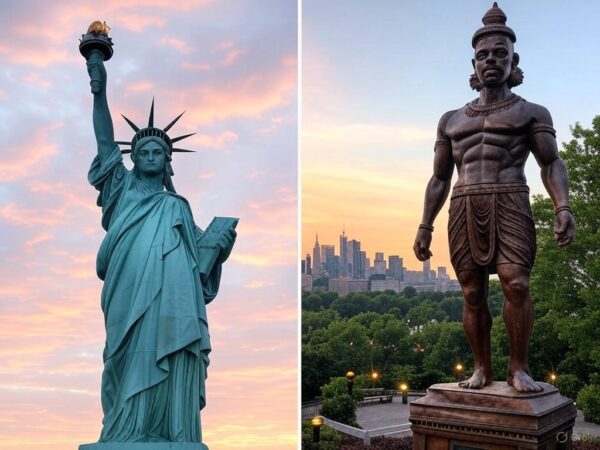Introduction

A few days ago, when the news about that huge Hindu image of Lord Hanuman was first going around, my friend Joe Rigney inquired if anyone knew whether @MichaelCassidy had anything going on these days. Michael Cassidy was that publicly-minded citizen who had redistributed the image of Satan that had been erected in the Iowa capitol building. As much as we might admire the honesty of such messaging by our politicians, the detestable image still needed to go.
Anyhow, Joe made his inquiry and his question excited some comment. Lord Hanuman does raise some interesting questions. Vandalism? Destruction of private property? Vigilantism? Liberty of conscience? What is going on here?
I have decided to tell you.
Show Outline with LinksTesting the Limits
First, before we get into the political theology of the thing, what we are looking at is a clear and naked instance of someone testing the limits. It is a matter of practical psychology first. This is a universal human phenomenon, and it goes on all the time. Pets do it, toddlers do it, sullen teen-age girls do it, and large immigrant communities do it. People naturally test boundaries. It is our way of finding out who is actually in charge.
Those who do the testing are the confident ones, and those who act the part of the nonplussed are not—please follow me carefully here—the confident ones. The question before the aggressive ones is “how far can we push this before someone says no?” The answer, at least to date, is “pretty far.” When the strong gods come, the weak gods give way.
Chesterton probably didn’t say it, but he should have. Those who don’t stand for something will fall for anything. We are now in such a state of civic disarray that we will fall for anything.
These Hindus know what they believe, and they have acted accordingly. Heartland Americans don’t know what they believe, and wouldn’t know how to defend it if they did know. They feel like something is wrong with this whole thing somehow, but cannot articulate it. When they try to raise their inchoate concerns at a family reunion, say, they have a learned cousin, a seminary grad, who patiently explains to them that this is the “price we pay for liberty.” And thus an appeal is being made to another giant statue, this one being up in New York, and not in Texas. The liberty that these Hindus have found here in the “land of the free” should actually be celebrated, the learned cousin explains.
Celebrated?
Before addressing the argument of our learned cousin, it needs to be pointed out that his demeanor is thoroughly compromised. His sophisticated dismissal of the whole thing, as though it did not constitute a grave problem, is an answer that has been marinating for some time now in a tray filled with wickedness and sin.
The apostle Paul was deeply distraught when he came to Athens, and why? Because the city was crammed with idols.
“Now while Paul waited for them at Athens, his spirit was provoked within him when he saw that the city was given over to idols.”Acts 17:16 (NKJV)
The word rendered here as “provoked” is paroxyno, the word from which we get our paroxysm. The apostle Paul was worked up over this, because idols and idolatry are always and everywhere an affront to the living God. Anyone who can take the proliferation of idols right in stride is someone who is not walking with the Spirit (Gal. 5:25). His stride doesn’t match the Spirit’s at all.
How could it be a matter of great distress that Athens was filled with idols and not be a matter of great distress that America is filling up with them?
So before we have our debate over what we should practically do about such displays, let us at least agree that their presence among us is a grief and abomination.
Battle of the Gods
In the image above, I juxtaposed a picture of the Statue of Liberty (305 feet tall) and the Lord Hanuman (90 feet tall, third tallest statue in the US). I am representing this as a battle of the gods, and right this minute the Statue of Liberty is losing. The Statue of Liberty is losing despite what the learned cousin says because, although she is taller, she is clearly the weak god. Defenders of a proliferation of idols will want to say that Liberty is winning because she has given her blessing to it. I say she is losing because she clearly has no idea how Planet of the Apes ended.
I should note that I am only talking about the Statue of Liberty in her current Nehushtan phase. As originally conceived, we should have no problem with such a welcoming presence in New York harbor, a glorious personification of actual liberty for those immigrants who were seeking it. But as liberty is currently conceived and defended, by people like the learned cousin, all such conceptions of liberty are the enemy of . . . liberty.
Aristotle once made the distinction between the behaviors that democracies like and the behaviors that will preserve democracies. We have a similar situation here. There are the behaviors that liberty likes and there are behaviors that will preserve liberty.
A disintegrating definition of liberty will necessarily descend into anarchic freedom . . . do what you feel, whenever and however you want. This is liberty with leprosy, and it is not long before the fingers start falling off. A corrupt conception of freedom will devour liberty. By way of contrast, the biblical understanding of liberty is form and freedom together, bounded liberty, liberty under law, liberty with clear definition. In short, it is liberty that knows how to defend itself . . . because it knows how to define itself. It is a servant of Christ.
This kind of liberty, the kind we have enjoyed for centuries now, is something that rests upon the bedrock of a Christian consensus. If you don’t have that as your foundation, you cannot have the building. Allow me to state it another way. Not all religious faiths value individual liberty. Religious liberty and toleration is a Christian value, and you cannot maintain religious liberty and toleration without maintaining the Christian basis for it. You cannot have one without the other. This means that if you have a liberty-loving republic that has historic Christian roots, you cannot maintain that liberty by bringing in boatloads of people who embrace a religious faith that is either hostile or indifferent to the very idea of liberty.
This is easy to mock, I know. But it is not divisive to warn the divisive man twice, and then to have nothing to do with him (Titus 3:10-11). Let the reader understand.
Think About It for a Minute
In the current “come one, come all” approach to immigration, has anyone thought this thing through? In the grip of the current mania for immigration that has gripped the center-left and leftward, whether that statue stays up or not is a simple question of whether we open the floodgates to a larger number of Muslims than Hindus. If the Muslims flood Texas, no more Lord Hanuman. Doesn’t anybody remember what the Taliban did to the ancient Bamiyan Buddha statues? Or we could go the other way—let us import a huge number of Hindus into Michigan and have ourselves our very own Pakistan/India border.
So I am not arguing for a commando attack on the idol, or a vigilante approach to it. This is a job for the civil magistrate to figure out. One of the first things to look at would be our immigration policy. This statue did not happen because a large number of native Texans started seeking enlightenment from the East. This happened because of a loose and reckless approach to immigration. A wise immigration policy does not tie two cats together by the tail and then throw them over a clothesline.
Having said this much, I do understand how easy it is to mock such a statement as nativistic jingoism. An appeal is made to the inscription on the Statue of Liberty—give me your huddled masses and so on. The idea is that we can import anybody from anywhere and in any amount, and have the only result be a larger array of choices when it comes to ethnic restaurants.
But answer me this. When the United Kingdom decided to import massive numbers of Muslims into their country, was this a triumph of British liberty or the suicide note of British liberty? If you decide to pour a large amount of white sand into the sugar bowl, at some point it becomes no longer a sugar bowl. Somebody should have anticipated this.
Postscript
And to anticipate the response of the ethnic idolaters, the sugar is sweet because it is Christian, not because it is white. I like brown sugar too.
And I must say I don’t have much use at all for the bros whose idea of a solution is to fill our bowls with Nordic white sand. The DNA of their sand is superior, or would be, if sand had DNA. And their mortal enemy is the left who are trying to make us all use brown sand. I can’t say that I have any use for either of these, um, views. All they know how to do is wreck the oatmeal.

